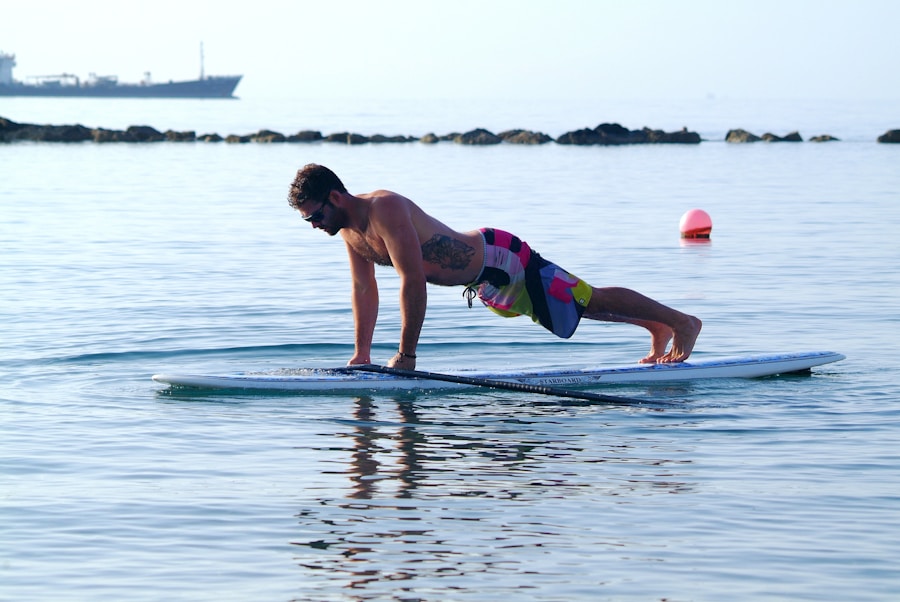Download links
How to install Surfing Makes Historic Debut at Olympics APK?
1. Tap the downloaded Surfing Makes Historic Debut at Olympics APK file.
2. Touch install.
3. Follow the steps on the screen.
Description
The journey of surfing towards Olympic inclusion is a fascinating narrative that intertwines the evolution of the sport with the broader cultural shifts in society. Surfing, which originated in ancient Polynesia, has long been more than just a sport; it embodies a lifestyle and a deep connection to the ocean. However, it wasn’t until the late 20th century that surfing began to gain recognition as a competitive sport on a global scale.
The establishment of professional surfing circuits, such as the World Surf League (WSL), helped to elevate the profile of surfing, showcasing its athleticism and artistry. This growing visibility laid the groundwork for its eventual inclusion in the Olympic Games. The International Surfing Association (ISA) played a pivotal role in advocating for surfing’s inclusion in the Olympics.
In 2016, during the 129th International Olympic Committee (IOC) Session in Rio de Janeiro, surfing was officially added to the program for the Tokyo 2020 Games. This decision marked a significant milestone, not only for surfers but also for the sport’s global community. The inclusion of surfing in the Olympics was seen as a recognition of its cultural significance and its appeal to younger audiences, aligning with the IOC’s goal of modernizing the Olympic brand and attracting new fans.
The journey to this point was not without challenges, as debates over the sport’s competitive format and its representation in the Olympic framework were ongoing.
Key Takeaways
- Surfing’s journey to Olympic inclusion has been a long and challenging one, with the sport finally making its debut at the Tokyo 2020 Olympics.
- The surfing competition format at the Olympics will consist of a series of heats, with athletes judged on the quality of their waves and maneuvers.
- Some of the top athletes to watch at the Olympics include Carissa Moore, Gabriel Medina, and Stephanie Gilmore, who are all expected to make a big impact in the competition.
- The impact of surfing at the Olympics is expected to bring greater visibility and recognition to the sport, potentially inspiring a new generation of surfers around the world.
- The history of surfing dates back centuries, with roots in Polynesian culture and a rich tradition of wave riding that has evolved into the modern sport we know today. The future of surfing at the Olympics holds great potential for growth and development, with the sport poised to continue making a significant impact on the global stage.
The Surfing Competition Format
Heat Structure and Judging Criteria
The event is structured as a series of heats, where surfers compete against each other in designated time slots, typically lasting 20 to 30 minutes. Each heat features two to four surfers who are judged based on their performance on a set of criteria, including wave selection, maneuver variety, difficulty, and overall flow.
Dynamics of Competition
This format allows for dynamic competition, as surfers must not only demonstrate their technical abilities but also strategically choose which waves to ride. In Tokyo 2020, the surfing events took place at Tsurigasaki Beach, where athletes faced the challenges posed by natural ocean conditions.
Scoring System and Unpredictability
Surfers were awarded scores by a panel of judges, with their best two waves contributing to their overall score in each heat. This scoring system emphasizes the importance of both consistency and peak performance, as surfers must balance risk-taking with strategic decision-making. The excitement of watching athletes navigate unpredictable waves adds an element of unpredictability that is unique to surfing competitions.
The Athletes to Watch

As surfing made its Olympic debut, several athletes emerged as frontrunners, capturing the attention of fans and experts alike. One standout was Carissa Moore from Hawaii, a three-time world champion known for her powerful style and competitive spirit. Moore’s journey to the Olympics was marked by her dedication to the sport and her commitment to inspiring young female surfers around the world.
Her ability to perform under pressure and her deep connection to Hawaiian culture made her a compelling figure in the competition. On the men’s side, Gabriel Medina from Brazil was another athlete to watch closely. Medina is celebrated for his innovative approach to surfing and his ability to execute complex maneuvers with precision.
As a former world champion, he brought a wealth of experience and skill to the Olympic stage. His rivalry with other top surfers added an extra layer of excitement to the competition, as fans eagerly anticipated head-to-head matchups that showcased their contrasting styles. Both Moore and Medina exemplified the spirit of surfing while representing their countries on one of the world’s largest athletic platforms.
The Impact of Surfing at the Olympics
| Year | Event | Gold Medalist | Silver Medalist | Bronze Medalist |
|---|---|---|---|---|
| 2020 | Men’s Shortboard | Italo Ferreira (BRA) | Japan Kanoa Igarashi (JPN) | Japan Gabriel Medina (BRA) |
| 2020 | Women’s Shortboard | Carissa Moore (USA) | South Africa Bianca Buitendag (RSA) | Japan Amuro Tsuzuki (JPN) |
| 2020 | Men’s Longboard | Peru Benoit Clemente (PER) | USA Kevin Skvarna (USA) | France Edouard Delpero (FRA) |
| 2020 | Women’s Longboard | USA Tory Gilkerson (USA) | France Alice Lemoigne (FRA) | Peru Maria Fernanda Reyes (PER) |
The inclusion of surfing in the Olympics has far-reaching implications for both the sport itself and its global community. One immediate impact is the increased visibility and legitimacy that comes with being part of such a prestigious event. For many aspiring surfers, seeing their sport represented on an international stage can serve as motivation and inspiration.
It opens doors for sponsorship opportunities and funding for grassroots programs aimed at developing young talent in various regions around the world. Moreover, surfing’s Olympic debut has sparked conversations about environmental sustainability and ocean conservation. As surfers are inherently connected to the ocean, many athletes have used their platforms to advocate for environmental issues affecting marine ecosystems.
The Olympics provide an opportunity for these athletes to raise awareness about climate change, pollution, and other pressing challenges facing our oceans. This intersection of sport and activism highlights how surfing can transcend mere competition, becoming a vehicle for positive change within communities and beyond.
The History of Surfing
Surfing’s history is rich and multifaceted, tracing back centuries to its origins in Polynesian culture. It was not merely a recreational activity; it held significant cultural importance among indigenous peoples who viewed it as a rite of passage and a way to connect with nature. Early accounts from European explorers in the 18th century documented these practices, but it wasn’t until the early 20th century that surfing began to gain traction outside of its traditional roots.
Iconic films like “Endless Summer” popularized surfing as a lifestyle choice rather than just a sport. This period saw the rise of surf culture, characterized by distinctive fashion trends, music, and art that celebrated the ocean and its waves.
As surfboards evolved from heavy wooden planks to lightweight fiberglass designs, so too did the techniques and styles employed by surfers. The sport continued to grow throughout the decades, leading to the establishment of professional competitions and organizations dedicated to promoting surfing worldwide.
The Future of Surfing at the Olympics

Expanding Categories and Diversifying Participation
One potential area for growth is expanding categories within competitive surfing, such as introducing new disciplines like big wave surfing or adaptive surfing for athletes with disabilities. These developments could further diversify participation and showcase different aspects of what makes surfing unique.
Sustainability and Environmental Stewardship
Additionally, as environmental concerns become increasingly pressing globally, there is an opportunity for Olympic surfing events to lead by example in sustainability practices. Initiatives such as eco-friendly event management, waste reduction strategies, and partnerships with conservation organizations could set a precedent for future sporting events. By aligning with environmental stewardship, surfing can reinforce its identity as a sport deeply connected to nature while inspiring other sports to follow suit.
A Legacy Beyond Medals
The ongoing evolution of surfing within the Olympic framework will undoubtedly shape its trajectory in years to come. As new generations of surfers emerge and push boundaries both in performance and advocacy, they will continue to redefine what it means to be an athlete in this dynamic sport. The legacy of surfing at the Olympics will not only be measured by medals won but also by its ability to inspire change and foster a deeper appreciation for our oceans and their preservation.
Surfing enthusiasts are eagerly anticipating the sport’s debut at the Olympics, with athletes from around the world vying for a chance to compete on the world stage. In a related article on taya365.info, readers can learn more about the excitement surrounding the upcoming surfing events and the potential for new stars to emerge in the sport. The article highlights the growing popularity of surfing and the opportunities it presents for athletes to showcase their skills on a global platform. As the countdown to the Olympics continues, fans are eagerly following the latest updates and news on the sport.
FAQs
What is surfing in the Olympics?
Surfing is a sport that involves riding ocean waves on a surfboard. In the Olympics, surfing is a competitive event where athletes showcase their skills in riding waves.
When was surfing introduced to the Olympics?
Surfing was introduced to the Olympics for the first time in the 2020 Tokyo Olympics. It was included as part of the Games’ efforts to attract a younger audience and promote more diverse sports.
How is surfing judged in the Olympics?
Surfing in the Olympics is judged based on the athletes’ ability to perform maneuvers on the waves, their style, and their overall performance. Judges consider factors such as speed, power, and flow in determining the scores.
What are the rules and regulations for surfing in the Olympics?
The rules and regulations for surfing in the Olympics are set by the International Surfing Association (ISA) and the International Olympic Committee (IOC). These rules cover aspects such as wave selection, time limits, and judging criteria.
Which countries are known for their strong surfing teams in the Olympics?
Countries with strong surfing teams in the Olympics include Australia, the United States, Brazil, and Japan. These countries have a rich surfing culture and produce top-level surfers who compete at the international level.
What are the different events in surfing at the Olympics?
In the Olympics, surfing features both men’s and women’s events. Each event includes a certain number of athletes competing in heats, with the top performers advancing to subsequent rounds until the medal matches.





